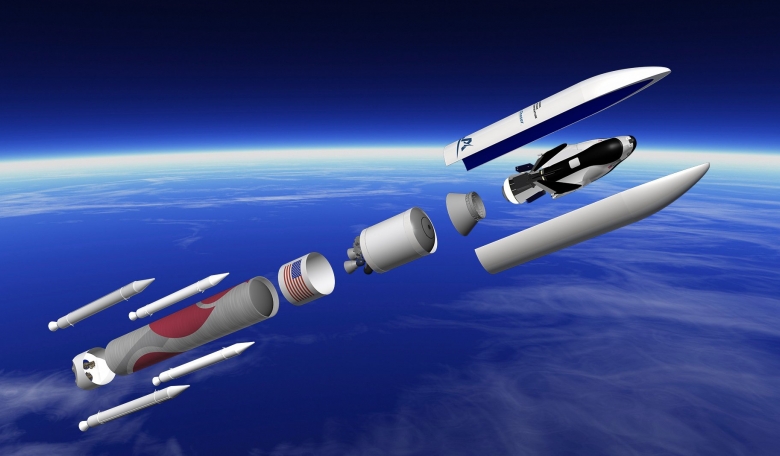The Vulcan Centaur rocket is supposed to be tailor-made for US national security. As soon as its second flight, however, United Launch Alliance's (ULA) big, new heavy-lift rocket will make its private-sector debut - before it's even fully certified.
ULA and Sierra Nevada Corp jointly unveiled an agreement on 14 August in a publicity briefing at the Louisville, Colorado, headquarters of SNC's Space Systems division: the Vulcan Centaur is contracted to launch SNC's privately-owned Dream Chaser spaceplane on six flights to deliver supplies to the International Space Station (ISS).
SNC had previously announced that ULA would launch at least the first two ISS resupply missions, likely on Atlas 5 rockets, but after meeting with five launch providers "in Japan, Europe - and also obviously Elon Musk and Jeff Bezos," said SNC's co-owner and president Erin Ozmen, SNC chose ULA largely for the Vulcan Centaur's "very competitive price". The actual number is a proprietary secret.
ULA has said the Vulcan Centaur is "purpose-built" for national security missions and has proposed it for the US Air Force's upcoming round of launch service procurement.
Dream Chaser's ticket to space is a series of six missions to deliver supplies to the ISS for NASA. SNC won the cargo resupply contract in early 2016 and since has started building the first Dream Chaser actually bound for orbit: an uncrewed variant with a cargo container on the back that burns up on reentry while Dream Chaser glides home to land on a runway. A Dream Chaser vehicle is expected to be reusable about a dozen times.
Choosing a virtually-brand-new rocket for Dream Chaser's first block of missions might seem risky, but SNC co-owner and CEO Fatih Ozmen credited ULA's record of 134 successful launches - 100 percent - as one of the deciding factors.
With the Dream Chaser test flight test vehicle as a backdrop, ULA's CEO Salvatore ‘Tory’ Bruno said during the news briefing that he expects the Vulcan Centaur to be ready for its first flight in early 2021. SNC foresees Dream Chaser's first mission launching in the fall of the same year.
"Atlas is also a backup," Bruno said. "We're on time with Vulcan but, if something should arise, we'll make sure we fly either way."
Meanwhile, parts and systems going on the Vulcan Centaur are already being tested on Atlas 5s. "We're going to sort of actually fly Vulcan before we fly Vulcan," Bruno said. "So all of the major elements of Vulcan - its payload fairing, its solid rocket boosters, its avionics, its software - are going to be feathered in on Atlas flights between now and then so that by the time we actually fly for you guys," he said, referring to SNC.
Unlike the three space capsules NASA projects will start carrying humans on test flights over the next few years, Dream Chaser glides back to Earth for a gentler reentry that's also more conducive to transporting sensitive science payloads.
Fatih Ozmen said Dream Chaser is "the only commercial spaceplane in the world, that exists, that is runway-landing-capable and reusable.
"So this is important because, you know, 50 years after the Apollo days, believe it or not, we're still using capsules - the high-G entry, the splash-in-the-ocean - for both cargo and crew."
SNC won a cargo-delivery contract with the Dream Chaser design, but the flight-test vehicle on display in SNC's lobby has windows for a reason.
That's because after funding initial work, NASA rejected SNC's proposal in 2014 for a passenger version of Dream Chaser to carry astronauts to and from the ISS. Hoping to free the US from relying on Russia to fly astronauts, NASA instead funded development, and eventually flights, on Boeing's Starliner and SpaceX's Crew Dragon capsules.
SNC came back about year later and won an undisclosed share of US$14 billion to develop the cargo version of Dream Chaser and to start making ISS supply runs. The $14 billion is split among three companies.
A crewed version of Dream Chaser isn't necessarily off the table for good. SNC still collaborates with NASA personnel on the design under an ongoing US Space Act agreement.
He couldn't give a timeline, but John Curry, SNC's programme director for the cargo contract, wants to believe: "We just need to do these cargo services and crew, I believe - this crew vehicle that you see right here? - I think that's going to happen."











